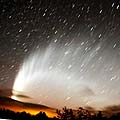
|
Excellent great comet, few times in a lifetime, for southern people. It reached to -5.5 mag on Jan. 14 and 15, brighter than Venus, and visible even in daytime. Then it appeared in the evening sky in the Southern Hemisphere and many people enjoyed a fantastic view of a beautiful great comet, a enormous curving tail with so many striae over 50 degrees. Now it is observable both in the evening and morning. It has already faded down to 7.5 mag (Mar. 19, Alexandre Amorim). In the Southern Hemisphere, It keeps observable almost all night until the comet has gone. It will never be observable again in the Northern Hemisphere.
Date(TT) R.A. (2000) Decl. Delta r Elong. m1 Best Time(A, h)
Mar. 17 22 57.81 -66 30.4 1.724 1.592 65 7.0 4:45 (331,-35)
Mar. 24 23 15.35 -68 23.4 1.777 1.718 70 7.4 4:34 (333,-36)
|
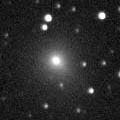
|
New bright comet discovered visually in the Southern Hemisphere. It seems to have been brightening gradually during last several months in the southern sky. It is moving northwards fast. It will become observable also in the Northern Hemisphere in the morning sky after early April. It will pass close to the earth and reach to 8 mag in April. Then it keeps observable until it fades out in the Northern Hemisphere. It will be visible visually until July.
Date(TT) R.A. (2000) Decl. Delta r Elong. m1 Best Time(A, h)
Mar. 17 20 42.55 -50 33.7 1.135 1.107 62 9.5 4:45 (324,-13)
Mar. 24 20 32.96 -46 13.4 0.983 1.095 67 9.2 4:34 (323, -7)
|

|
Not yet observed in this return. But it must be brihtening very rapidly towards the perihelion passage on Apr. 4. Rober Matson and Wentao Xu informed the comet became visible in the SWAN images in mid March. However, it is not observable until April. It will appear in the morning sky at 8 mag in mid April in the Northern Hemisphere, or at 10 mag in late April in the Southern Hemisphere. Then the condition will get better rapidly. However, the comet will fade out rapidly. It will be fainter than 14 mag in mid May, too faint to see visually.
Date(TT) R.A. (2000) Decl. Delta r Elong. m1 Best Time(A, h)
Mar. 17 23 41.98 -24 25.6 1.439 0.649 22 11.6 4:45 (281,-30)
Mar. 24 0 20.30 -16 48.6 1.286 0.459 18 9.2 19:38 ( 88,-26)
|

|
It will reach to 6 mag at the perihelion passage in mid April. Now it is 11.0 mag (Mar. 11, Reinder J. Bouma). Now it is brightening rapidly, however, it locates extremely low in the evening sky and hard to observe. It will be unobservable in mid April. After conjunction with the sun, it appears in the morning sky at 12 mag in June. But it locates only 20 degree high at most, and it will be fading rapidly. In the Southern Hemisphere, it appears in the morning sky at 8 mag in May, then it will be bright and observable for a while.
Date(TT) R.A. (2000) Decl. Delta r Elong. m1 Best Time(A, h)
Mar. 17 1 10.74 14 0.3 1.613 0.846 26 10.8 19:32 (101, 8)
Mar. 24 1 31.64 15 38.4 1.494 0.721 24 10.2 19:38 (105, 7)
|
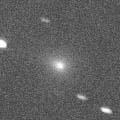
|
First return of a new bright periodic comet observed at 9 mag in 2001. It brightened rapidly also in this return. It was 16.1 mag on Jan. 11 (Filip Fratev), but it brightened up to 11.1 mag on Mar. 11 (Reinder J. Bouma). Unexpectedly, it became as bright as at the discovery, and visible visually. However, the condition of this apparition is bad. It keeps locating very low in the evening until early May. It kept brightening even after passing the perihelion, but it will be fading after this.
Date(TT) R.A. (2000) Decl. Delta r Elong. m1 Best Time(A, h)
Mar. 17 1 54.60 7 20.5 1.646 0.985 33 11.7 19:32 ( 90, 14)
Mar. 24 2 27.83 9 0.9 1.661 1.020 35 12.0 19:38 ( 91, 14)
|

|
Now it is 12.6 mag (Mar. 9, Edwin van Dijk). It has been 12 mag for half a year since last June. But it will start fading after this. It will be too faint to see visually in April. However, the fading is slow. The comet will be fainter than 18 mag in 2008. In the Northern Hemisphere, it keeps observable until that time. In the Northern Hemisphere, it keeps observable all night for a while after this.
Date(TT) R.A. (2000) Decl. Delta r Elong. m1 Best Time(A, h)
Mar. 17 21 47.13 68 27.4 2.533 2.435 72 13.4 4:45 (206, 35)
Mar. 24 22 34.31 70 8.7 2.624 2.482 70 13.5 4:34 (204, 33)
|

|
In this season, it has been bright as 12-13 mag and visible visually since it appeared in the morning sky in early July. It is visible visually as 12.7 mag still now (Mar. 17, Carlos Labordena). It will be getting lower in the evening sky after this. It will be too low to see in April.
Date(TT) R.A. (2000) Decl. Delta r Elong. m1 Best Time(A, h)
Mar. 17 3 59.17 28 27.5 6.196 5.892 67 13.7 19:32 ( 95, 49)
Mar. 24 4 3.40 28 28.8 6.299 5.894 61 13.8 19:38 ( 98, 43)
|
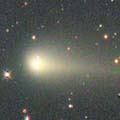
|
It reached up to 9.3 mag between October and November (Oct. 27, Juan Jose Gonzalez). It had been observable in excellent condition. But it is fading now. It has already faded down to 13.1 mag (Mar. 8, Reinder J. Bouma). However, it keeps observable after this until May when it fades down to 16 mag.
Date(TT) R.A. (2000) Decl. Delta r Elong. m1 Best Time(A, h)
Mar. 17 5 1.71 13 22.0 1.966 2.041 79 13.9 19:32 ( 61, 54)
Mar. 24 5 16.00 13 58.2 2.071 2.078 76 14.2 19:38 ( 67, 51)
|

|
Bright as 13.8 mag visually (Mar. 17, Alan Hale). Approaching to the earth rapidly now, and it will reach to 13 mag in early April. It is observable in good condition. However, it will fade out rapidly after that, and it will be low in the evening sky soon. It will be unobservabel in late May.
Date(TT) R.A. (2000) Decl. Delta r Elong. m1 Best Time(A, h)
Mar. 17 15 8.81 -25 54.7 0.851 1.628 123 14.8 3:34 ( 0, 29)
Mar. 24 14 14.48 -23 18.5 0.656 1.569 142 14.0 2:14 ( 0, 31)
|

|
Now it is 13.4 mag (Mar. 10, Luis Alberto Mansilla). It has been 13 mag for a long time since last autumn. However, it will be fading gradually after this. It is observable in good condition in the Southern Hemisphere, although it is already not observable in the Northern Hemisphere.
Date(TT) R.A. (2000) Decl. Delta r Elong. m1 Best Time(A, h)
Mar. 17 16 15.93 -70 30.7 1.998 2.319 95 14.3 4:40 ( 0,-15)
Mar. 24 16 27.05 -71 41.0 1.991 2.361 98 14.3 4:23 ( 0,-17)
|

|
It reached up to 4 mag in 2006 autumn. But it had faded down to 10.5 mag on Jan. 11 (Carlos Labordena). Now it is not observable. It will appear in the morning sky again at 15-16 mag in May. Then it keeps observable until it becomes fainter than 18 mag in autumn.
Date(TT) R.A. (2000) Decl. Delta r Elong. m1 Best Time(A, h)
Mar. 17 22 30.29 -8 21.6 3.708 2.792 19 14.4 4:45 (276, -7)
Mar. 24 22 36.08 -8 35.6 3.746 2.878 25 14.5 4:34 (277, -4)
|

|
It has been visible at 13.5 mag for a long time since 2005 autumn until 2006 spring. Now it is fainter than last year by 1 mag, however, it is still visible visually at 14.2 mag (Dec. 22, Seiichi Yoshida). It keeps observable in excellent condition until April.
Date(TT) R.A. (2000) Decl. Delta r Elong. m1 Best Time(A, h)
Mar. 17 13 3.18 24 5.6 4.894 5.782 150 14.5 1:28 ( 0, 79)
Mar. 24 13 0.01 24 10.0 4.906 5.805 151 14.5 0:57 ( 0, 79)
|

|
Now it is 14.4 mag (Feb. 12, Juan Jose Gonzalez). Almost asteroidal. It did not brighten at all since early September. Although the slight cometary activity was detected in late July, it became completely stellar soon. Its tail became visible again in late October, however, it turned to be stellar again soon. Finally it has passed the perihelion, keeping almost asteroidal. It kept observable at 14 mag in good condition in the Northern Hemisphere for a long time. However, it will be fading after this. It will start getting lower in April, and will be too low in the evening sky at 17 mag in June.
Date(TT) R.A. (2000) Decl. Delta r Elong. m1 Best Time(A, h)
Mar. 17 5 57.94 25 2.1 1.186 1.595 93 14.8 19:32 ( 61, 72)
Mar. 24 6 18.79 22 14.0 1.295 1.655 91 15.1 19:38 ( 61, 67)
|
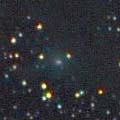
|
It became brighter than expected, and now it is visible visually at 14.2 mag (Mar. 14, Alan Hale). It keeps observable in the evening sky until May. It is not observable around the perihelion passage in July in conjunction with the sun. Then it moves to the southern sky, and it will be unobservable in the Northern Hemisphere.
Date(TT) R.A. (2000) Decl. Delta r Elong. m1 Best Time(A, h)
Mar. 17 3 52.92 43 15.2 2.523 2.395 71 15.3 19:32 (118, 52)
Mar. 24 4 8.02 42 22.8 2.542 2.341 67 15.2 19:38 (117, 48)
|

|
Now it is 15.2 mag (Feb. 24, Ken-ichi Kadota). Although it had been unobservable since last autumn, now it is appearing again in the morning sky. It will be observable at 14.5 mag from spring to summer both in 2007 and 2008. The condition is good, and it may be visible visually.
Date(TT) R.A. (2000) Decl. Delta r Elong. m1 Best Time(A, h)
Mar. 17 19 1.34 -12 26.8 6.261 6.011 71 15.4 4:45 (314, 29)
Mar. 24 19 0.61 -11 51.6 6.121 5.993 77 15.3 4:34 (318, 32)
|

|
Now it is 15.3 mag (Jan. 7, Ken-ichi Kadota). It is observable at 15.5-16 mag until spring. But, in the Northern Hemisphere, it locates somewhat low at 20-30 degree high.
Date(TT) R.A. (2000) Decl. Delta r Elong. m1 Best Time(A, h)
Mar. 17 4 41.27 -25 1.7 4.026 3.888 74 15.9 19:32 ( 36, 20)
Mar. 24 4 38.29 -23 52.2 4.125 3.890 69 16.0 19:38 ( 44, 16)
|
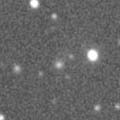
|
Now it brightened up to 16.0 mag (Feb. 21, Ken-ichi Kadota). It keeps 15.5-16 mag for one year and a half after this until 2008 summer. However, because the comet moves southwards, it is only observable until 2007 June in the Northern Hemisphere.
Date(TT) R.A. (2000) Decl. Delta r Elong. m1 Best Time(A, h)
Mar. 17 10 33.97 2 1.2 2.753 3.713 162 16.1 22:54 ( 0, 57)
Mar. 24 10 28.67 1 44.8 2.743 3.667 154 16.0 22:22 ( 0, 57)
|

|
Now it is 16.8 mag (Dec. 29, Katsumi Yoshimoto). It is outside of Jupiter's orbit. So it keeps 17 mag for a long time until 2007 summer. It keeps locating high and observable in good condition for a long time after this because it moves in the northern sky.
Date(TT) R.A. (2000) Decl. Delta r Elong. m1 Best Time(A, h)
Mar. 17 14 38.02 40 28.2 6.661 7.276 124 17.1 3:02 (180, 85)
Mar. 24 14 33.96 40 39.7 6.649 7.293 126 17.1 2:31 (180, 84)
|

|
It was observed at 19 mag in mid December. It brightened up to 18 mag on Feb. 15. It will reach to 17 mag in spring, and will be observable in good condition.
Date(TT) R.A. (2000) Decl. Delta r Elong. m1 Best Time(A, h)
Mar. 17 10 49.82 6 13.9 1.337 2.313 165 17.1 23:10 ( 0, 61)
Mar. 24 10 45.64 6 51.2 1.345 2.297 157 17.1 22:39 ( 0, 62)
|
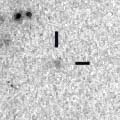
|
It was observed at 17.5 mag in 2006 spring. It will be observable at 17 mag in good condition in 2007 spring.
Date(TT) R.A. (2000) Decl. Delta r Elong. m1 Best Time(A, h)
Mar. 17 14 12.23 -13 13.9 3.913 4.724 140 17.1 2:36 ( 0, 42)
Mar. 24 14 10.05 -13 6.9 3.850 4.725 148 17.1 2:07 ( 0, 42)
|

|
It has already faded down to 16.3 mag (Jan. 30, Ken-ichi Kadota). It keeps a good contition until spring, while the comet will be fading gradually.
Date(TT) R.A. (2000) Decl. Delta r Elong. m1 Best Time(A, h)
Mar. 17 9 8.79 26 27.2 4.021 4.777 135 17.2 21:30 ( 0, 81)
Mar. 24 9 6.47 26 13.8 4.165 4.841 127 17.3 21:00 ( 0, 81)
|

|
It reached to 16 mag in early 2006. Now it is 17.3 mag (Dec. 2, Ken-ichi Kadota). It will be fading very slowly from 17 mag to 18 mag until 2007 summer. In the Northern Hemisphere, it keeps locating high.
Date(TT) R.A. (2000) Decl. Delta r Elong. m1 Best Time(A, h)
Mar. 17 14 17.46 34 5.6 5.117 5.828 131 17.3 2:42 ( 0, 89)
Mar. 24 14 14.34 34 18.5 5.116 5.855 134 17.4 2:11 ( 0, 89)
|

|
Very far new comet. It will be observable at 17.5-18 mag more than one year after this.
Date(TT) R.A. (2000) Decl. Delta r Elong. m1 Best Time(A, h)
Mar. 17 9 39.23 -5 1.3 7.945 8.803 147 17.4 22:00 ( 0, 50)
Mar. 24 9 38.14 -4 30.9 7.996 8.801 141 17.5 21:32 ( 0, 50)
|

|
It will reach to 11 mag in 2009 summer and autumn. It keeps observable in good condition until 2009 summer in the Northern Hemisphere. But after the maximum brightness, it goes to the southen sky. It will be 14 mag in 2008 summer and visible visually. Then it keeps visible visually for one year.
Date(TT) R.A. (2000) Decl. Delta r Elong. m1 Best Time(A, h)
Mar. 17 5 33.72 48 15.2 7.816 7.868 89 17.6 19:32 (134, 68)
Mar. 24 5 32.65 48 4.2 7.882 7.821 82 17.6 19:38 (128, 62)
|

|
It reached to 16.5 mag at best in December and January. But now it is already fading. It will be fainer than 18 mag in April.
Date(TT) R.A. (2000) Decl. Delta r Elong. m1 Best Time(A, h)
Mar. 17 6 32.43 26 56.6 1.950 2.356 101 17.7 19:32 ( 48, 79)
Mar. 24 6 40.69 26 36.3 2.038 2.364 96 17.8 19:38 ( 62, 74)
|

|
It had been lost since its discovery in 1986. But it was rediscovered on Jan. 9 at 16-17 mag. The condition is good in this return, and it was expected to reach to 14 mag from autumn to winter. But actually, it is fainter than originally expected, and it reached to 17 mag at best. Now it is 17.4 mag (Feb. 11, Mitsunori Tsumura). It will be fainter than 18 mag soon.
Date(TT) R.A. (2000) Decl. Delta r Elong. m1 Best Time(A, h)
Mar. 17 2 12.27 14 6.0 2.381 1.736 39 18.8 19:32 ( 93, 21)
Mar. 24 2 31.29 15 36.8 2.462 1.779 37 19.0 19:38 ( 97, 19)
|

|
Peculiar asteroid moving along a cometary orbit. It will approach to Sun down to 0.6 A.U. in late April. Then it will pass very near by Earth in May. The condition to observe it is very bad. Nobody can observe it until late May in the Northern Hemisphere. In the Southern Hemisphere, it will be observable in the morning low sky from late April to mid May. It will be 18.5 mag at best if it keeps asteroidal. However, if it shows cometary activity, it may be observed at 12-14 mag in the Southern Hemisphere. Then it may be visible visually at 11 mag in the evening sky in late May also in the Northern Hemisphere.
Date(TT) R.A. (2000) Decl. Delta r Elong. m1 Best Time(A, h)
Mar. 17 0 41.70 -2 55.6 2.000 1.064 14 19.4 19:32 ( 92, -8)
Mar. 24 0 41.40 -4 0.2 1.925 0.955 9 19.0 19:38 ( 96,-15)
|
|
![]()
 2P/Encke
2P/Encke 185P/2007 A3 ( Petriew )
185P/2007 A3 ( Petriew ) C/2006 L2 ( McNaught )
C/2006 L2 ( McNaught ) 29P/Schwassmann-Wachmann 1
29P/Schwassmann-Wachmann 1 4P/Faye
4P/Faye C/2007 E1 ( Garradd )
C/2007 E1 ( Garradd ) C/2005 YW ( LINEAR )
C/2005 YW ( LINEAR ) C/2006 M4 ( SWAN )
C/2006 M4 ( SWAN ) C/2003 WT42 ( LINEAR )
C/2003 WT42 ( LINEAR ) P/2006 HR30 ( Siding Spring )
P/2006 HR30 ( Siding Spring ) C/2006 XA1 ( LINEAR )
C/2006 XA1 ( LINEAR ) C/2005 L3 ( McNaught )
C/2005 L3 ( McNaught ) C/2005 EL173 ( LONEOS )
C/2005 EL173 ( LONEOS ) C/2006 V1 ( Catalina )
C/2006 V1 ( Catalina ) C/2002 VQ94 ( LINEAR )
C/2002 VQ94 ( LINEAR ) 87P/Bus
87P/Bus 99P/Kowal 1
99P/Kowal 1 C/2005 E2 ( McNaught )
C/2005 E2 ( McNaught ) C/2004 D1 ( NEAT )
C/2004 D1 ( NEAT ) C/2007 D1 ( LINEAR )
C/2007 D1 ( LINEAR ) C/2006 W3 ( Christensen )
C/2006 W3 ( Christensen ) P/2006 U5 ( Christensen )
P/2006 U5 ( Christensen ) 184P/2007 A1 ( Lovas 2 )
184P/2007 A1 ( Lovas 2 ) 2006 WD4
2006 WD4![]()




















